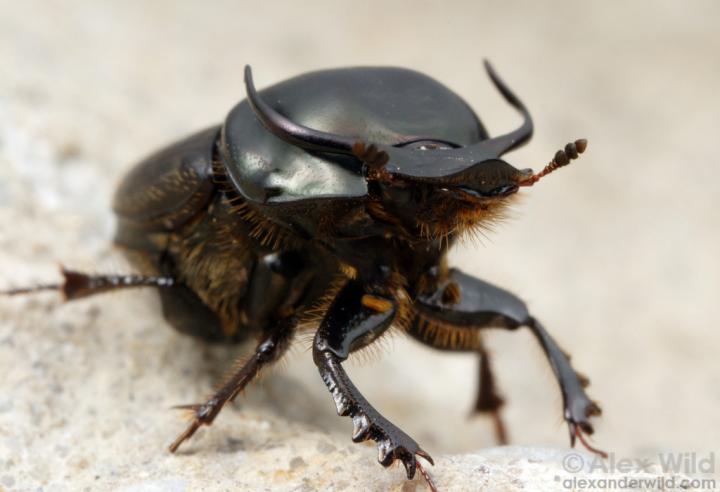![The study used beetles in the species <i>Onthophagus taurus</i> to learn about the role played by the dsx gene to “match” physical traits to males versus females. [Alex Wild]” /><br />
<span class=](https://genengnews.com/wp-content/uploads/2018/08/Feb27_2017_AlexWild_Beetle1427114011-1.jpg) The study used beetles in the species Onthophagus taurus to learn about the role played by the dsx gene to “match” physical traits to males versus females. [Alex Wild]
The study used beetles in the species Onthophagus taurus to learn about the role played by the dsx gene to “match” physical traits to males versus females. [Alex Wild]
The doublesex (dsx) gene, which matches gender-specific traits to males and females, is no mere “switch.” The dsx gene is, rather, surprisingly versatile. Once thought of as a unidirectional suppressor of male traits in females, the dsx gene has been revealed to be a dual-action regulator.
The new findings come from a genome-wide study conducted by scientists based at Indiana University. The scientists decided to examine the workings of the dsx gene, which is conserved across species, in beetles, partly because the insects present exaggerated differences in physical traits between males and females. For example, in the beetle Onthophagus taurus, males possess elaborate horns to battle rivals over females. These horns do not offer a similar reproductive advantage to females, however—large horns would interfere with their ability to dig tunnels used to nest offspring.
Although they may show sex differences more dramatically than many other species, beetles manage a common problem. Like other species, they manage the tension that can exist between natural selection, which favors traits that promote a species’ survival, and sexual selection, which favors traits that attract mates. If a species lacks this ability to “buffer” between male and female traits, it can go extinct.
“We want to know more about this gene because it helps us answer a major question about development and evolution: How do animals with similar genomes—such as males and females of the same species—produce different versions of the same trait? And why do some traits, like ornamental features that attract mates, vary so widely, while others, like legs, don't?” said Cris Ledón-Rettig, Ph.D., a researcher at Indiana University.
Dr. Rettig led a study that pursued these questions by combining systemic dsx knockdown, high-throughput sequencing of diverse tissues, and a genome-wide analysis of Dsx-binding sites. The results of this work appeared February 27 in the journal Nature Communications, in an article entitled, “Asymmetric Interactions between Doublesex and Tissue- and Sex-Specific Target Genes Mediate Sexual Dimorphism in Beetles.”
“We find that Dsx regulates sex-biased expression predominantly in males, that Dsx's target repertoires are highly sex- and tissue-specific and that Dsx can exercise its regulatory role via two distinct mechanisms: as a sex-specific modulator by regulating strictly sex-specific targets, or as a switch by regulating the same genes in males and females in opposite directions,” wrote the article’s authors. “More generally, our results suggest Dsx can rapidly acquire new target gene repertoires to accommodate evolutionarily novel traits, evidenced by the large and unique repertoire identified in head horns, a recent morphological innovation.”
The fine-grained control that dsx exerts over male and female traits is possible because the gene acts in a surprising variety of ways, explained Dr. Ledón-Rettig. By activating different genes in males and females, for example, it can promote male or female versions of the same trait, such as genitalia. Or, by activating the same genes in males while simultaneously inhibiting them in females, it can promote opposite traits.
“The power to prevent the expression of male traits in females, and vice versa, is a critical feature,” added Armin Moczek, Ph.D., a professor in the biology department at Indiana University and a co-author of the current study. “It buffers traits that benefit only members of one sex from causing harm in members of the other.”
By conducting a genome-wide study, the Indiana University researchers were able to identify over 1000 points on the genome in normal beetles where dsx affected gene expression in males and over 250 points where it affected gene expression in females. Importantly, Dr. Ledón-Rettig noted, the majority of these points did not overlap. This indicated that dsx didn't simply turn certain genes “on” or “off” for most of the traits studied but rather affected gene expression at different locations in the genome based on sex.
“Essentially, dsx instructs the development of male and female versions of the same trait by influencing different genes in each sex,” she pointed out.
This was especially the case when they looked at the effect of dsx on the brains, which regulates sex-specific behaviors, and genitalia, used in reproduction. But for one trait—head horns—the study showed that dsx sometimes targets the exact same genes in both sexes. In this situation, dsx regulated the genes in opposite directions, creating completely horned males and completely hornless females. When the scientists disabled dsx, both sexes developed similarly sized intermediate horns.
“We're eager to extend our work on role of dsx—and other genes—to sexual differences across other, closely related species of beetles,” Ledón-Rettig commented. “These beetles are really a powerful platform for unraveling the fundamental mechanisms that underlie evolutionary diversification of sexual traits across species.”







